Monday, April 18, 2011
1982-83 Calgary Flames Kent Nilsson Jersey
When the Flames relocated from Atlanta to Calgary in 1980, the became the new tenants of the Stampede Corral.
The Corral was built in 1950 at a cost of $1.25 million Canadian dollars to replace the Victoria Arena, which dated back prior to World War I. It had 6,475 seats but could hold over 8,700 fans including standing room only patrons and when it was constructed it was the largest arena in Canada west of Toronto.
It originally was home of the Calgary Stampeders hockey club, who were then members of the Western Canadian Senior Hockey League. The Stampeders turned professional the following season when the joined the Pacific Coast Hockey League for one season prior to joining the Western Hockey League for the next 11 seasons. During their third year in the WHL, the Stampeders won the league championship for the only time in their five trips to the finals before folding in 1963.
The next club to call the Stampede Corral home was the Calgary Buffaloes, who became the Centennials after one season, a junior hockey team which began play in 1966. They played each of their 11 seasons the Corral, reaching the Western Canada Hockey League finals once in 1974 prior to relocating to Billings, Montana. John Davidson and Lanny McDonald were the most notable of the Centennials.
Before their departure, the Centennials shared the arena with the return of professional hockey to Calgary when the Vancouver Blazers of the World Hockey Association moved to Calgary and became known as the Calgary Cowboys, who featured one of the worst logos in professional sports history.
The Cowboys were doomed to be a financial failure, as the Stampede still only held 6,500 fans, which the franchise could not even fill. Ownership was hoping the arena would be expanded to 15,000 seats, but attendance during their second season was less than 4,500 fans and, when only 2,000 signed up for a third season, the franchise folded in the summer of 1977 after only two seasons of play.
Immediately filling the departure of the junior hockey Centennials were the Calgary Wranglers, who relocated from Winnipeg. The Wranglers played in Caglary for ten seasons, making the finals once before moving yet again in 1987. Future Flames goaltender Mike Vernon would be the best known of the Wranglers.
In 1980 the Atlanta Flames ownership was suffering from considerable financial difficulty and sold the Flames to Nelson Skalbania for a record $16 million. Skalbania moved his new purchase to Calgary, keeping both the name and the jerseys, with only a change in logo from a flaming "A" to a flaming "C". The Flames were an immediate success playing in the Stampede Corral for their first three seasons prior to moving in 1983 to the 19,000 seat Olympic Saddledome, which had been constructed in anticipation of the 1988 Winter Olympics.
The Flames had a great debut season at the Sampede Corral, finishing with a 39-27-14 record and making it to the NHL playoff semifinals. Their third season saw them qualify for the playoffs, and after defeating the Vancouver Canucks, they faced their Alberta rivals the Edmonton Oilers in the playoffs for the first time ever.
The ascendant Oilers won the first two games in Edmonton prior to returning to Calgary for games 3 and 4. The Oilers embarrassed the Flames 10-2 in Game 3, but the Oilers sent the arena off in style in front of 7,242 fans with a 6-5 win in the final NHL game ever played at the Stampede Corral on this date in 1983 after building a 6-2 win and holding on through a furious Oilers rally during the final ten minutes. The series would then move to Edmonton, where the Oilers would oust the Flames from the playoffs.
The Stampede Corral is still used for the annual Calgary Stampede rodeo exhibition and festival as well as other events such as basketball, wrestling, boxing and concerts. It also hosted the 1972 World Figure Skating Championships, some hockey games during the 1988 Winter Olympics.
Today's featured jersey is a 1982-83 Calgary Flames Kent Nilsson jersey as used in the final NHL game at the Stampede Corral when the Flames defeated the Edmonton Oilers. As stated previously, the Flames jerseys remained unchanged following their move from Atlanta, save for a change in logo.
Nilsson would lead the Flames in scoring during their first season in Calgary while placing third in the league scoring race behind only Wayne Gretzky and Marcel Dionne with 131 points. After an injury shortened season in 1981-82, he rebounded to lead the Flames in scoring once more during their last season at the Stampede Corral with 103 points, which tied him for ninth place overall.
Bonus Jersey: Today's bonus jersey is a 1975-76 Calgary Cowboys Ron Chipperfield jersey from another tenant of the Stampede Corral, the Calgary Cowboys of the WHA. The Cowboys only lasted two seasons before folding.
Chipperfield played eight professional seasons with Vancouver, Calgary and Edmonton of the WHA and then moved with the Oilers to the NHL, where he later played with the Quebec Nordiques. His final professional season was spent in Italy where he won the league scoring title with an amazing 78 goals and 128 points in a mere 30 games!
Extra Bonus Jersey: Today's extra bonus jersey is a 1983-84 Calgary Wranglers Darryl Daignault jersey from the junior team which played at the Stampede Corral from 1977 to 1987 prior to becoming the Lethbridge Hurricanes.
This attractive jersey is reminiscent of the Winnipeg Jets jerseys of the same time period, only with stripes that run down the sides of the jersey and not across the waist, proving to be ahead of it's time, as that is now a common design element.
It also features a great logo of a cowboy roping an italicized "W", a dynamic look which was light years ahead of the Calgary Cowboys lame "Charlie Brown in a cowboy hat" logo.
Today's video highlights begin with a look at the Calgary Stampede, held every July.
This next video of cowboy Glenn Stewart putting his horse through a series of obstacles contains enough long shots to give you an idea of how small the Corral is, making it hard to imagine an NHL team ever called it's cozy confines home.
Subscribe to:
Post Comments (Atom)

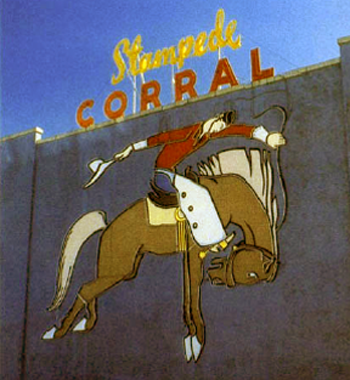

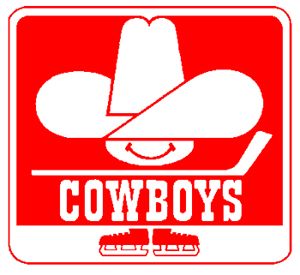

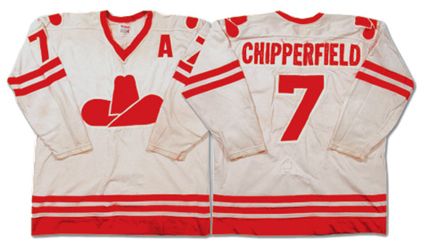
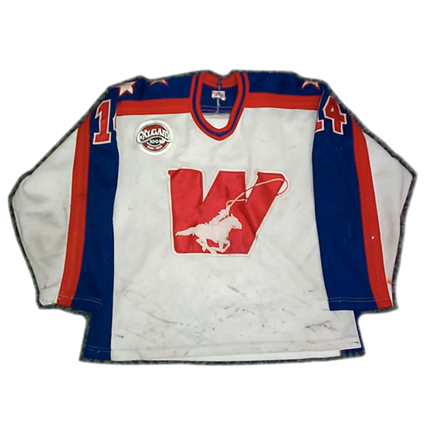
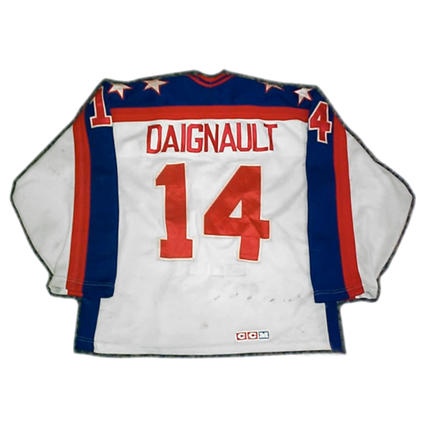










No comments:
Post a Comment
We welcome and encourage genuine comments and corrections from our readers. Please no spam. It will not be approved and never seen.